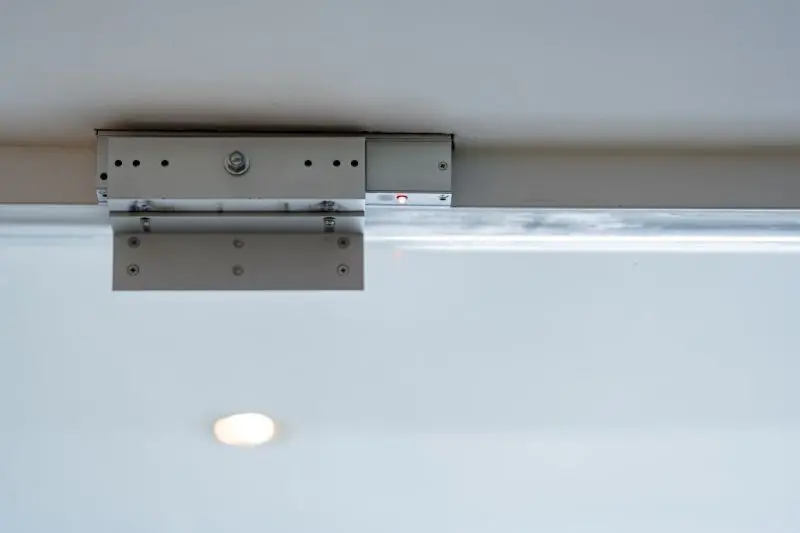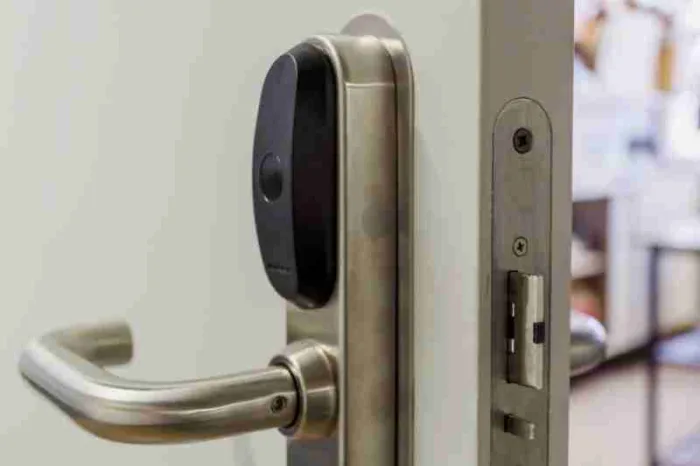Takeaways
- The best maglock brands include Dormakaba, Assa Abloy, and Schlage.
- Maglocks are a type of locking mechanism that uses electromagnetism to secure an entrywaykj.
- Magnetic locks use an electromagnet and armature plate located on the doorframe and the door, respectively. The electromagnet is provided with low-voltage power to magnetize it, so the door locks in place when the armature plate comes into contact with it.
- Access control is the best use case for electromagnetic locks because of the level of security they offer.

While residents and visitors on your property might not think much of the type of lock you use to secure your doors, it’s a choice that impacts both security and convenience. Many buildings use maglocks to secure and release their apartment doors through an apartment intercom with a door release mechanism. So, should you start using maglocks on your property?
In this post, you’ll learn the best magnetic lock brands. Additionally, you can discover the purpose of maglocks, how they work, and how to effectively implement them into your property.
This post covers:
- 3 best maglock brands
- What does a maglock do?
- How does a magnetic lock work?
- Why use maglocks on your property?
3 best maglock brands
Your unique property will determine which electromagnetic locks will work best for you. The main differences in the following brands are their holding forces, prices, and designs.
The three best magnetic lock manufacturers are:
1. Dormakaba
Established in 1980, Dormakaba offers electromagnetic locks designed for heavy-duty applications and any other door you must secure. With a maximum holding force of 1,200 pounds, Dromakaba’s maglocks are suitable for various properties.
Dormakaba’s maglocks feature numerous models based on the entryways you’re looking to control. Depending on your needs, you’ll find magnetic locks that fit your needs, from sliding and double doors to delayed egress and weather resistance.
Overall, Dormakaba’s catalog of electromagnetic locks and deadbolt locks features:
- Limited lifetime warranty
- Built-in time delay
- Surge protection
- Keyhole mounting
- Door status sensors
- Security condition sensors
- Up to 1,200lb holding force
- Applicable to virtually any door
2. Assa Abloy
Assa Abloy’s electromagnetic locks are designed to ensure fail-safe functionality while complying with CE and RCM standards. Perfect for either retrofit or new installations, their maglocks offer dual voltage flexibility in both 12V and 24VDC. Moreover, Assa Abloy’s maglocks are built for a 1,200-pound holding force.
Assa Abloy maglocks encompass numerous beneficial qualities:
- 5-year warranty
- Monitored and non-monitored options
- Recessed options for sliding or swing doors
- Fixing options on materials like wood, aluminum, glass, and steel
- Up to 1,200lb holding force
3. Schlage
Schlage has been in locking hardware since 1920, making them a veteran in the door security industry. Their full suite of magnetic locks encompasses everything from basic access control to maximum security. With a holding force of up to 3,000 pounds, Schlage designed their maglocks to serve numerous applications. For example, Schlage maglocks include models for retrofitting an existing door or installing a new entryway.
Maglocks from Schlage include:
- Limited lifetime warranty
- 400lb to 3,000lb holding force
- Mortise and surface mount options
- Magnetic gate locks available
- Built-in status monitoring
- Dual voltage options
What does a maglock do?
A maglock, also known as a magnetic or electromagnetic lock, is a type of door lock that uses magnetism to secure a barrier, typically a door or gate.
Magnetic locks use low-voltage power to lock entryways and increase property security. The power supply keeps the lock’s electromagnet energized, which keeps it in the locked position. Then, when someone uses a credential to unlock the door, the power supply is removed, releasing the magnetic lock and opening the door.
Maglocks are considered fail-safe because they automatically unlock doors during a power outage.

Fail-safe vs. fail-secure
Industry professionals often use the terms fail-safe and fail-secure to refer to maglocks and electric strikes, respectively. You can remember the difference this way: During a power outage, maglocks keep people safe by unlocking. Conversely, electric strikes keep areas secure by remaining locked.
Many properties use both maglocks and electric strikes according to the security needs of specific areas. But before you decide, you should research local municipal regulations and fire codes to ensure your building is safe while following local laws.
What is the purpose of a magnetic door lock?
The purpose of a magnetic door lock is to maintain secure access at a property while maintaining safety procedures when a building loses power. In that case, building occupants can quickly exit the building without needing a credential, which is essential in an emergency.
Maglocks vs. analog locks
Magnetic locks have several benefits compared to analog locks. For one, they can be stronger. Depending on the type of lock you buy, you would need to exert up to 2,000 pounds of force to bypass one.
Maglocks were invented in the late ’60s. And as the access control world continues to embrace other advances in technology, the usefulness of maglocks becomes even more apparent.
Unlike an analog lock, magnetic locks can be wired to engage and disengage even if a person isn’t directly at the door. You can electronically instruct maglocks to do whatever your property might need.
For instance, you can set a magnetic lock to automatically unlock and lock at specific times. Or, you can set a delayed egress maglock to unlatch after a few seconds.
Additionally, you can wire a maglock to access control hardware like keypads, fingerprint scanners, and intercoms. One keypad can control multiple maglocks, which is useful for larger properties that assign different levels of access permissions to different PINs. Today, you can even program a maglock to unlock remotely with a smartphone app.
What are the different types of maglock?
There are two main types of magnetic locks: surface-mounted and mortice.
A surface-mounted lock gets its name from the place it’s installed. Installers mount this type of maglock on the surface of the doorframe.
A mortise lock, also known as a shear lock or recessed lock, is another option if you want to hide the nuts and bolts of a maglock. Shear locks are smaller than surface-mounted maglocks because they depend on pins that help keep a door in place when closed.
What is the difference between a maglock and a door strike?
The main difference between a magnetic lock and a door strike is the power requirements.
Maglocks are fail-safe, meaning they require power to remain magnetic and secure a barrier. When that power is cut, the barrier is no longer secure because there is no magnetism keeping the door in place.
Conversely, electric door strikes are fail-secure, unlocking when they receive a short burst of power. So, when an electric strike isn’t being powered, its default state is locked.
Learn about the differences between electric locks and magnetic locks:
How much does it cost to get a maglock?
On average, maglocks cost about $300. However, this number depends on the strength of the magnetic lock and if you want to include any other features. For example, a popular feature that properties often request is a battery backup — which will increase costs.
How much does it cost to install a maglock on a door?
Generally speaking, the cost to install a maglock on an average door is approximately $300. Nonetheless, installation costs will vary based on the complexity of the installation and the installer you use.
How does a magnetic lock work?
A magnetic lock works by using electromagnetic force to keep a door closed.
More specifically, maglocks utilize two primary components to operate:
- Electromagnet. Located in or on the door frame, the electromagnet physically secures the door via magnetism. The device is only magnetic when it’s powered by a constant stream of electricity.
- Armature plate. Also known as a door plate, this part is the metal installed on the door. When the electromagnet on the door frame is energized, the door plate is attracted to it, and the electric holding force keeps the mag door shut.
Magnetic door locks are often connected to access control systems. So, when an authorized credential is presented to the access reader, the system cuts power to the electromagnet, unlocking the door and letting the user inside.
Do mag locks work when the power goes out?
Maglocks do not work when the power goes out. To keep a door locked, maglock doors depend on electricity. Without that electricity, a maglock will disengage — something you should keep in mind if you want to prepare your property for a blackout.
Can you force a magnetic lock?
No. Magnetic locks cannot be forced open as they are designed to withstand much force. The strength of a maglock is known as its holding force. Maglocks can have a holding force of as little as 200 pounds or as high as 3,000 pounds. The level of security your property requires will determine which type of holding force is best for you.
Why use maglocks on your property?
You should use maglocks on your property because they’re an extremely secure door-locking mechanism — especially when paired with a robust access control solution.
Together, maglocks and access control ensure your property is only accessible to authorized personnel. Keypads and card readers will work in tandem with magnetic locks to secure a wide range of entryways, from the front gate and package room to server rooms and amenity spaces.
Not to mention, maglocks create safe environments in the event of a power outage or emergency. In fact, many fire codes require the use of magnetic locks in certain areas for this very reason. For example, if there’s an emergency like a fire, people must be able to exit your building quickly. A door or gate that unlocks in the event of a power failure is the safest option.
While the major drawback of magnetic door locks is their cost, these systems are ideal solutions for apartments, gated communities, industrial facilities, commercial buildings, and more. What’s more, maglocks work in many different applications, from the gate and front door to storage closets and amenities. To benefit the most from your maglock system, pair it with a cloud-based access control system.

Learn more about ButterflyMX
Fill in the form below, and we'll email you right back.
Have questions?
Fill in the form below, and we'll email you right back.






